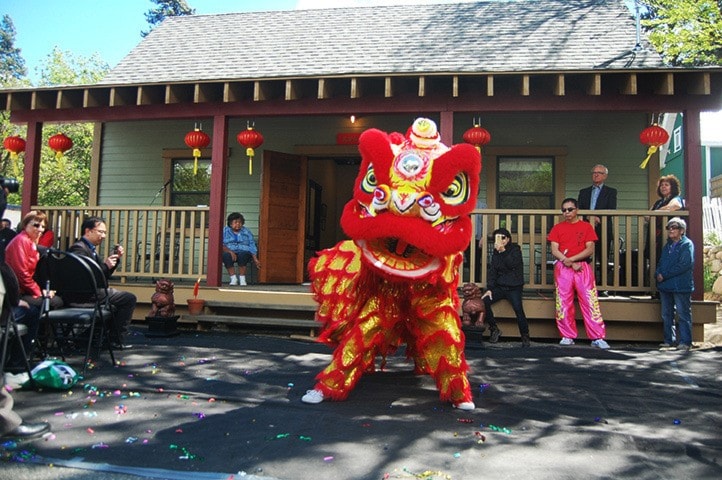A 1933 article in the Vancouver Province newspaper called “Gods in a Lytton Woodshed”, which talked about the Lytton Joss House and the history of the land on which it had stood, has resulted in the creation of a new museum celebrating the history of Lytton’s Chinese community. Fittingly, the Lytton Chinese Museum stands on the same plot where the joss house stood from 1881 until it was torn down in 1928.
The piece of land at the south end of Main Street was owned by Bernie and Lorna Fandrich of Kumsheen Rafting, who had purchased it in 1980. It was not until some time later that they came across the 1933 article and learned of the site’s history. Lorna, a history buff, vowed to build a facility that recognized the contributions of the Chinese community in the town over the decades.
“I thought for a long time about doing something with the lot when I retired from Kumsheen,” says Lorna. Even though she is still working there part-time, a catalyst for moving ahead with a museum came when the site received heritage status from the province of B.C. early in 2016.
Bernie says that he began excavation work at the site last April, digging out the foundation, and also building a retaining wall out of boulders around the site. Construction then began on a museum that would house artefacts and an altar where incense could be burned and prayers made. With the exception of a $1,000 donation from an old friend, the money to construct and fill the museum has come from Lorna and Bernie.
Lorna began the search for artefacts, picking up pieces she knew were part of the story and receiving donations from three or four people. Then she heard from Kamloops resident Al Dreyer, who had a large collection of Chinese artefacts relating to the town and the region.
“I started collecting around 1974, when I moved to Lillooet,” says Dreyer. He assembled some 150 items over the years, many of them from Ashcroft. “When they cut the road leading down to the River Inn, it went through a dumping ground that had been used by the Chinese community.” Many of the Chinese residents of Ashcroft lived in the area now occupied by the River Inn and the Legacy Park.
“There were a lot of Tiger Whiskey pots,” says Dreyer. “They look like vases, and come in many different colours. You’d never think you could dig things out of the ground a hundred years later and they’d still be in one piece.” Using a metal detector, he also found numerous Chinese coins on the lot where the carwash now stands.
“I moved to Kamloops in 2016 and had to downsize,” he says. “By word of mouth I heard that Lorna was looking for Chinese display items. I wanted to sell it as one lot, and she came and looked at it and said ‘Wow.’
“It worked out really well. I can go see it whenever I want, and it won’t get sold off. Lorna says she’ll put a picture of me on the wall of the museum. I said ‘Wait until I’m dead.’”
Some 140 people attended the museum’s official opening on May 14, and were able to tour the building, which has three rooms containing display items. Various dignitaries—including David Chong, who represented his family, which has deep roots in the community; Lily Chow of the New Pathways to Gold Society; Lytton mayor Jessoa Lightfoot; Lytton First Nation chief Janet Webster; and LFN councillor John Haugen—spoke about the museum and the village’s Chinese heritage, and a Buddhist monk blessed the building.

(from l) Lily Chow, Lorna Fandrich, David Chong, Al Dreyer, Janet Webster, and Jessoa Lightfoot at the opening of the Lytton Chinese Museum. Photo by Barbara Roden
Lorna and Bernie spoke and thanked the many people who helped make the museum a reality. The opening ceremony ended with the Shao Lin Hun Gar Lion Dance team from Vancouver performing a colourful dance, to the delight of the crowd.
Lily Chow says she gave some advice on Chinese calligraphy and the layout of the displays to Lorna. “Lorna had lots of ideas, and was very good and very obliging and very humble.
“We didn’t want it to be a temple. It really brings back memories of the older times; a place where people can go for prayer and comfort and peace.” She notes that above the altar are statues of three deities. “Zhu Rong is the God of Fire, because we need a god here to control fire. Shen Nong is the God of Agriculture, to teach people how to cultivate the land and look for medication. And Quan Yon, is the Goddess of Mercy.”

The altar, with (from left) deities Zhu Rong, Quan Yon, and Shen Nong. Photo by Barbara Roden
David Chong is very impressed. “Some of our family is in it, which is of special interest. They’ve done a remarkable job in terms of presentation.”
The Lytton Chinese Museum is now open five days a week, Thursday through Monday, from 11:30 a.m. to 5:30 p.m. at 145 Main Street, and will be open on demand through the winter. Admission is $8 for adults and $5 for children aged 10 to 16 (children up to age 9 are free).
